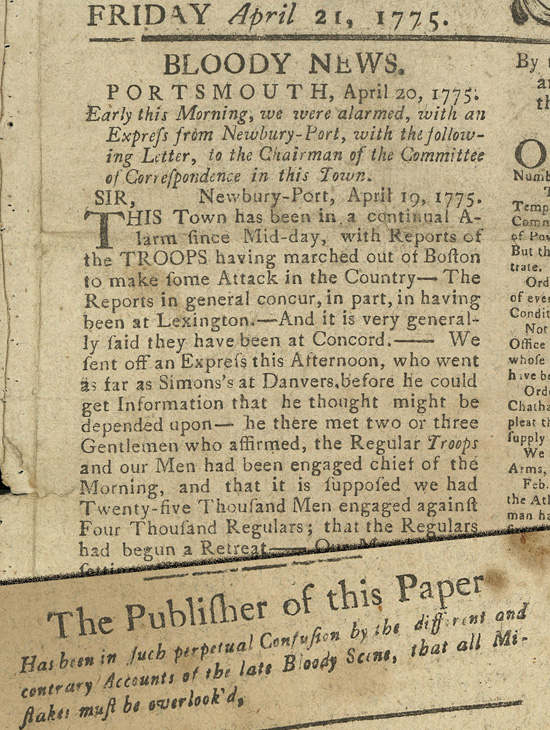We live in a time of constant debate and discussion about political and military media coverage. Whether it is a presidential election or rebellion in the Middle East, the role of 21st-century media is constantly scrutinized. So, now is perhaps the best time to study media coverage of the American Revolution and the birth of the United States. And what better place to start than with the "shot heard 'round the world."
The biggest news story of the 18th century was arguably the violence at Lexington and Concord, the first full battle of the American Revolutionary War.
The engagement took place on Wednesday, April 19, 1775. Most of Boston's newspaper printers had fled town just before or after the battle, so details emerged at an express rider's pace and then were often delayed a little longer while waiting for weekly newspaper press dates. The pro-Crown Boston News-Letter was the first of two Boston papers to go to press following the bloodshed and published a brief, disclaimer-heavy paragraph in its April 20 edition. The neutral Boston Evening-Post printed one last issue, only two pages long, on April 24, which included a single related sentence: "The unhappy Transactions of last Week are so variously related that we shall not at present under take to give any particular Account thereof."
Printed 60 miles north of Boston, the New-Hampshire Gazette featured news of Lexington and Concord on the front page of its Friday, April 21 issue. Only two colonial printers in all 13 colonies placed this breaking news on the front page of their newspapers, displacing the typical foreign reports, advertisements or serial essays.
The April 21 New-Hampshire Gazette is also historically significant for being the only American newspaper, of 38 being printed at the time, to use an actual headline, not the usual dateline or letter salutation, for its first report of Lexington and Concord. Headlines were rarely used in early newspapers so a centered headline -- "BLOODY NEWS" -- in the New-Hampshire Gazette surely caught colonists' attention. The unique headline alerting New Englanders to the start of the American War of Independence deserves a spot at the top of the list of most important newspaper headlines in history. The article continues with an urgent -- if confused -- report from Newburyport sent by James Hudson, chairman of the local Committee of Correspondence, to Portsmouth's Committee. According to journalism historian Frank Luther Mott:
"Daniel Fowle, editor of the paper which alone of all the colonial press gave both position and headline to the Lexington story, was, as we are told by Isaiah Thomas, who knew him well, 'pacific in his disposition, agreeable in his manners, liberal in his sentiments, and attached to the cause of his country.' He is noteworthy as the founder of the New-Hampshire Gazette, which for many years before its suspension in 1943 was the oldest of American newspapers," (New England Quarterly, Vol. 17, No. 4, Dec., 1944, pp. 489-505).
With a shortage of Boston newspapers immediately following the Battle of Lexington and Concord, historians have long relied on the published accounts from nearby communities, like Portsmouth (New-Hampshire Gazette), Salem (Salem Gazette, Essex Gazette), Norwich (Norwich Packet), New Haven (Connecticut Journal), Providence (Providence Gazette), Newport (Newport Mercury), and Worcester (where Isaiah Thomas relocated his Massachusetts Spy). Historian David Hackett Fischer cited many of these, including the April 21 issue of the New-Hampshire Gazette, as being "specially helpful" for the research of his popular Paul Revere's Ride (1994).
Lesser known about the April 21 issue of the New-Hampshire Gazette is Fowle's testimony about the chaos of incoming reports about the battle and his own plea for forgiveness of all errors. Tucked away in the bottom corner of the fourth and final page, Fowle prints: "The Publisher of this Paper Has been in such perpetual Confusion by the different and contrary Accounts of the late Bloody Scene, that all Mistakes must be overlook'd."
Todd Andrlik is one of America's leading Revolutionary War newspaper archivists, and serves as author and curator at raglinen.com, an online museum of historical newspapers. His book, Reporting the Revolutionary War: Before It Was History, It Was News, publishes this November. The book features hundreds of newspaper accounts published during the American Revolution and includes sprinkles of modern historical analysis by dozens of historians and experts. Portions of this blog post are excerpted from Andrlik's forthcoming book and his current column in American Revolution Magazine.
